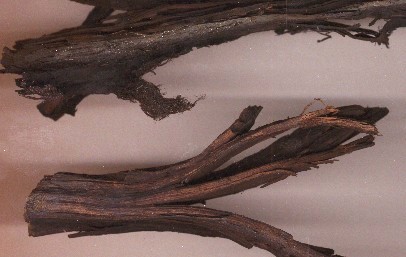|
|||||||||||||||||||
Gray FossilSite
Oak leaves, approximately 1/3 enlarged. The best-preserved leaves occur in the gray clays
beneath the dark organic layers.Wood and Plant material

Wood fragments, roughly natural size, curled and split by careless drying (even slowly in a cellar). Fibrous bark, still strong and flexible, suggests cedar or cyprus (x4).
Detail of wood, x2.
Fragment of hardwood, approximately
natural size, and detail, x4. Correct color
is near black.
Portion of stem, 2/3 natural size, and
detail of knot, x2. Presumably once
round in cross section, the stem is now
about 40 percent as thick as it is wide, a
reduction to 40 percent its original volume,
other dimensions the same. Note the
absence of bark and appearance
suggestive of transport by water.
Specimen recovered by Robert Price.
Twigs and woody debris are abundant. On examination,
this one's unsymmetrical cross section is the result of
uneven compression and coalification. The collapsed side
is dense and reflective, while radial and concentric woody
structure remain prominent in the rest. Three views, x4, and
detail, x8.
Carbonized oak leaf in soft laminated clay and silt. Image is approximately natural size.
Home | Links | Bone Gallery | Sediments and invertebrates | Geologic features | Drillholes and stratigraphy | Geologic map | Scenes and activities